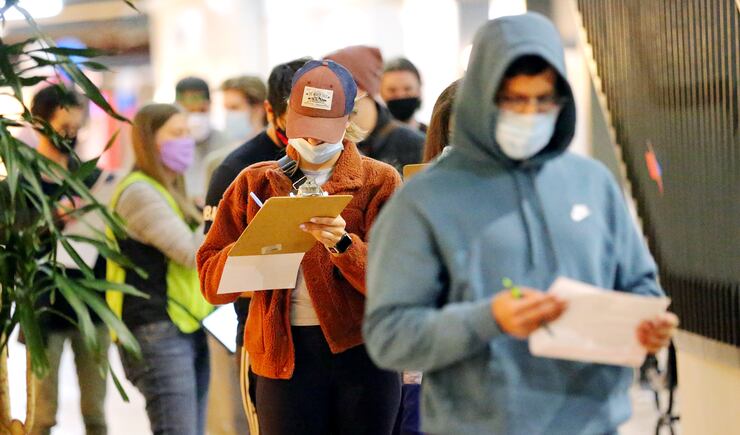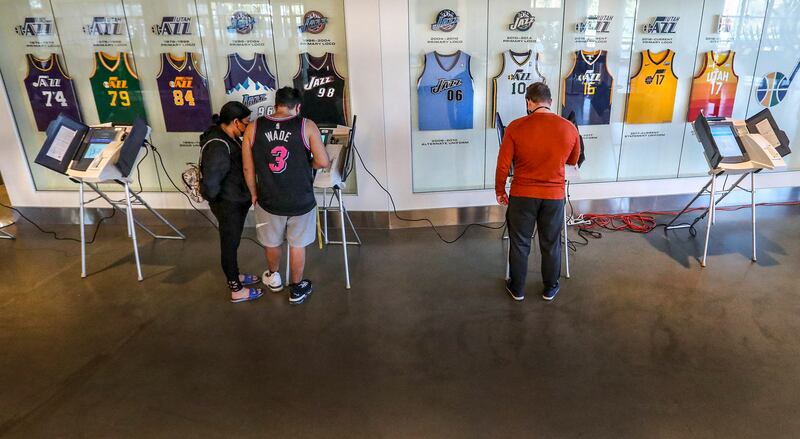SALT LAKE CITY — More Utahns voted in the 2020 election than any other in history, the state elections office reported Tuesday.
“We’ve broken the record for total number of voters,” said state Elections Director Justin Lee. “Right now we’re at 1.214 million voters. Previously, 1.15 million voters was our record set in 2016.”
He said 72.2% of active registered voters have participated, with that percentage expected to increase before all the votes are counted. The record active voter participation of 82% was established in 2016.
He added that the record for overall eligible voter population voting was set in 2004 with 59.8% engaging in the process. That number could be in danger as well, but it will be a couple of weeks before official final totals will be known.
“Nothing is ultimately certified statewide until Nov. 23, which is when we do the statewide canvass with certification of results,” Lee said. “We’ll have some preliminary numbers in the next couple of days, but that’s when we’ll know the final numbers.”
He said that while the COVID-19 outbreak did prompt increased mail-in voting, the number of people choosing vote by mail had already been growing steadily over the years.
“We would have been voting by mail even if there wasn’t a pandemic, that’s the way we would have been voting,” he said. “This turnout shows that vote by mail really works well, so in the future people have more confidence in the system.”
Utahns who did not vote by mail lined up at designated polling locations throughout the state Tuesday. Meanwhile, some downtown businesses boarded up windows and planned to close early in case of any potential civil unrest.
Capt. Tanner Jensen, director of the Statewide Information and Analysis Center, a branch of the Department of Public Safety, said the tense political climate that plagued Utah and the country this summer had officials ready to combat a number of potential threats — whether that was people tampering with election systems, demonstrations boiling out of control, or a single person looking to “make a statement in a violent manner,” he said.
“We really have been dealing with the demonstrator versus counterdemonstrator, which sometimes can become confrontational. So that’s kind of our biggest issue,” Jensen said. “As far as vandalism, buildings being attacked, we really haven’t seen a whole lot of that outside of a couple days here in Utah.”
Still, some businesses in Salt Lake City didn’t take any chances Tuesday night, including several around the City Creek Center whose employees spent Monday boarding up windows with plywood. According to its website, the mall closed at 5 p.m. Tuesday and would again Wednesday.
A Nordstrom spokesperson told KSTU Monday that its stores were preparing for any activities that might take place on Election Day “and potentially in the days following. We’re taking steps to keep our customers and employees safe and our stores secure.”

Other stores, including Sunglass Hut, Michael Kors, Ebar and Tiffany were also boarded up at City Creek Monday evening.
“I probably won’t be headed downtown, like some of the other rioting times,” said Toni Taylor, who spent Monday in the downtown area with her family. “You just, you know, stay home, stay safe.”
Salt Lake Police Sgt. Keith Horrocks said officers kept a low profile near polling locations Tuesday so as not to incite any reactions simply by their presence.
“We met with the ACLU, we also met with the county recorder, and speaking with them it was determined that the best practice is that you don’t really have a uniformed law enforcement officer at the polls, because there are folks that are going to vote where that could cause an intimidation factor,” Horrocks said.
“But behind the scenes there is a lot going on … we’re ready if something happens.”
There was a small gathering near the Salt Lake County Government Center on State Street, where a group of Trump supporters and Black Lives Matter protesters organized on opposite streets from each other. Although there were reports of several armed protesters on both sides, Horrocks said Tuesday was relatively quiet.
“Our folks went down there and chatted with them and made sure they were 150 feet from the polling location, which they were,” he said. “We’re happy that so far today it’s been peaceful.”
Horrocks noted that Salt Lake police have had a lot of practice this year dealing with crowd control, protests and riots, and have learned a lot from each incident about how to improve their techniques.
But by 10 p.m., things remained calm in Salt Lake City.
In Duchesne County, the sheriff’s office is investigating reports of a volunteer poll worker turning voters away at the county administration building. According to a statement issued Tuesday night, police say initial information suggests it was a miscommunication between the poll worker and a voter.
Physical threats to election security weren’t the only thing the Utah Department of Public Safety had to prepare for, and cybersecurity was an equally important aspect. Jensen says he has confidence in the state’s election cybersecurity. Misinformation, however, is something he says increasingly “causes concern and distrust, sows discord among voters.”
“We ask that you use websites that are trusted ... media sites that are trusted as well to get your information during the election,” Jensen said.

Leading up to Election Day, 67% of approximately 1.68 million registered voters in the Beehive State had already cast their ballots, Lee said, and scores more voted in person.
“Right now, we’re at 1,126,000 processed and there’s obviously thousands more in the mail and people voting in the polling places today,” Lee said Tuesday. “We have more coming in and at this point, I’ll be shocked if we don’t break every kind of record for voting in Utah.”
He said 82% of registered voters participated in 2016, the most in recent history. The state record for percentage of voter turnout was in 1960 for the John F. Kennedy-Richard Nixon presidential race in which 89% of Utahns cast ballots. However, the state’s eligible voter population was at 419,000 people back then, he noted.
Generally speaking, voter turnout happens in a few waves throughout the day, he said.
“There’s three different spikes — usually first thing in the morning, we have a pretty good rush of people,” Lee explained. “Then usually around midday we’ll see people around the lunch hour, then close of business starting around 5:30 p.m. or 6 p.m. we usually have another spike.”
What impact the pandemic will have on in-person turnout is still to be determined.
In Salt Lake County, election officials said the number of individuals voting by mail this year “far exceeds anything we’ve seen in the past.”
“The numbers are huge. We had a record number of people register,” said Salt Lake County Clerk Sherrie Swenson. “Also, compared to 2016, we’ve had about 100,000 additional voter registrations. On Election Day in 2016, the final report was 510,000, now it’s over 610,000.”
Contributing: Dan Rascon, Debbie Worthen, Pat Reavy

































































